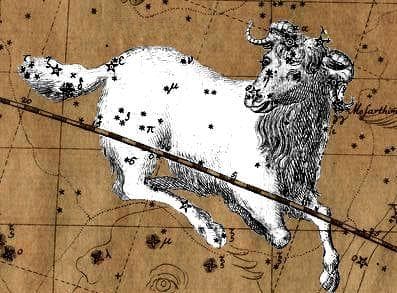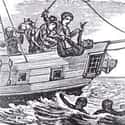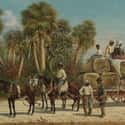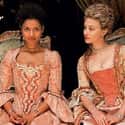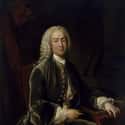-
(#11) Her Later Life Is Not Well Known, Though She Did Get Married And Have Three Children
When Lord Mansfield passed away in 1793, he left Belle a respectable inheritance and clearly stated in his will that she was a free woman. Five months after his passing, Belle moved out of Kenwood and married a man named John Davinier, the son of a reverend. After that, the details of her life get hazy. Historians know that she had three children and passed away of "natural causes" at age 41. The cemetery where she was reportedly buried has been moved, and today no one knows the new location of her grave.
-
(#2) She Was Likely Familiar With A Landmark Case In Abolitionist History
The Zong Insurance Case (also known as the Zong Massacre) was one of the most prominent slavery-related cases of the 1700s, and Belle's guardian, Lord Mansfield, was one of the judges overseeing it.
Originally a Dutch slave ship, the Zong was purchased by Englishmen; in 1781, it was used to transport 442 African slaves to the Caribbean. The ship made a navigational error and overshot Jamaica, leading to a critical shortage of drinking water. The crew claimed that in order to save the "healthy" slaves, those who were ill were thrown overboard – 132 people in total. The legal case back in England was coldly simple: the owners of the slave ship sued their insurance company, who refused to pay for the loss of what the owners saw as "goods."
The language used in the case was a chilling example of how African slaves were seen in the 18th century: "Blacks are goods and property; it is madness to accuse these well-serving honorable men of [slaying]... The case is the same as if wood had been thrown overboard."
At the time, Belle served as Lord Mansfield's secretary, and presumably was exposed to documents and letters about the case. In the 2013 film Belle, she becomes actively involved; however, historians have no way of knowing what her actual role in the case was, or if she had one at all.
The original claim was ultimately dropped. Although the insurance company demanded a new trial, there is no record stating that one actually took place. However, once knowledge of the case began to circulate, it lit a spark that provided vital fuel for the abolitionist movement.
-
(#9) Her Parents Probably Lived Together In Florida For A Time
University of West Florida archaeologist Margo Stringfield believes that attitudes toward infidelity in 1700s Florida were much more relaxed than they were back in England. America and the Caribbean were seen as the frontier, where some of the rules didn't apply. It's possible that during the early years of their relationship, John Lindsay and Maria Belle lived together in Pensacola, FL, at least while Lindsay wasn't at sea.
In an interview with the Telegraph, Stringfield said, "It was not unusual for men in frontier settings to have women with them that were not their wives," and that Maria "probably had women friends in a similar situation to herself here."
-
(#7) She Was Brought To England After Her Mother Passed Away
Belle was brought to England in 1766; she was around five years old at the time. She had been living with her mother, Maria Belle, until she passed away. Her father, a Naval officer, could not take care of Belle on his own, so he sought help from his well-connected family. He convinced his uncle, the 1st Earl of Mansfield, to take in his young daughter, thus providing her with protection and a comfortable life.
-
(#5) She Was Raised Alongside The Daughter Of Another Family Member
When Belle was brought to Lord Mansfield's home in 1766, she joined another young girl who had also lost her mother. Lady Elizabeth Murray was raised at Kenwood while her father, a cousin of Lord Mansfield, served as an ambassador to Austria and France.
Lord and Lady Mansfield decided that Belle would make a good playmate for Elizabeth, and the two girls grew up with a close bond. They were both considered family, but they each received very different allowances – Belle received £30 each year, while Elizabeth received around £100.
The Lord and Lady never had any biological children. Belle and Elizabeth were the only children they ever knew, and they reportedly cared for them as if they were their own.
-
(#3) As A Judge, Lord Mansfield Made Rulings That Were Popular With Abolitionists
The 1st Earl of Mansfield was the Lord Chief Justice of Britain, the most powerful judge in the country. In 1772, he presided over a landmark case, that of a runaway slave named James Somerset. He ruled that slave masters had no jurisdiction over escaped slaves while they were in England (and could not remove them from British soil against their will), making Somerset a free man.
Although slavery carried on in foreign countries, Lord Mansfield didn't want to see it on his home soil. The ruling was considered a key moment in the abolitionists' fight to end the slave trade, and many believe his anti-slavery views were inspired by his great niece Belle.
New Random Displays Display All By Ranking
About This Tool
Dido Elizabeth Belle was born in the British West Indies. Her father Sir John Lindsay was a British nobleman and navy captain, and her mother Maria Belle was an African slave. In 1765, Dido moved to England, his uncle, Earl of Mansfield, raised her up, and she became a wealthy heiress and the first influential aristocrat of African descent in the UK. Dido grew up in Kenwood, a royal estate on the outskirts of London, and was allowed to receive a royal education.
The portrait of Scottish painter David Martin has attracted the attention of the public, this painting is hung in the Scone Palace in Scotland. People can clearly see that her skin color does not make her inferior in Kenwood. The random tool introduced 12 facts about the first black aristocrat in the UK who lead to the abolition of slavery.
Our data comes from Ranker, If you want to participate in the ranking of items displayed on this page, please click here.

